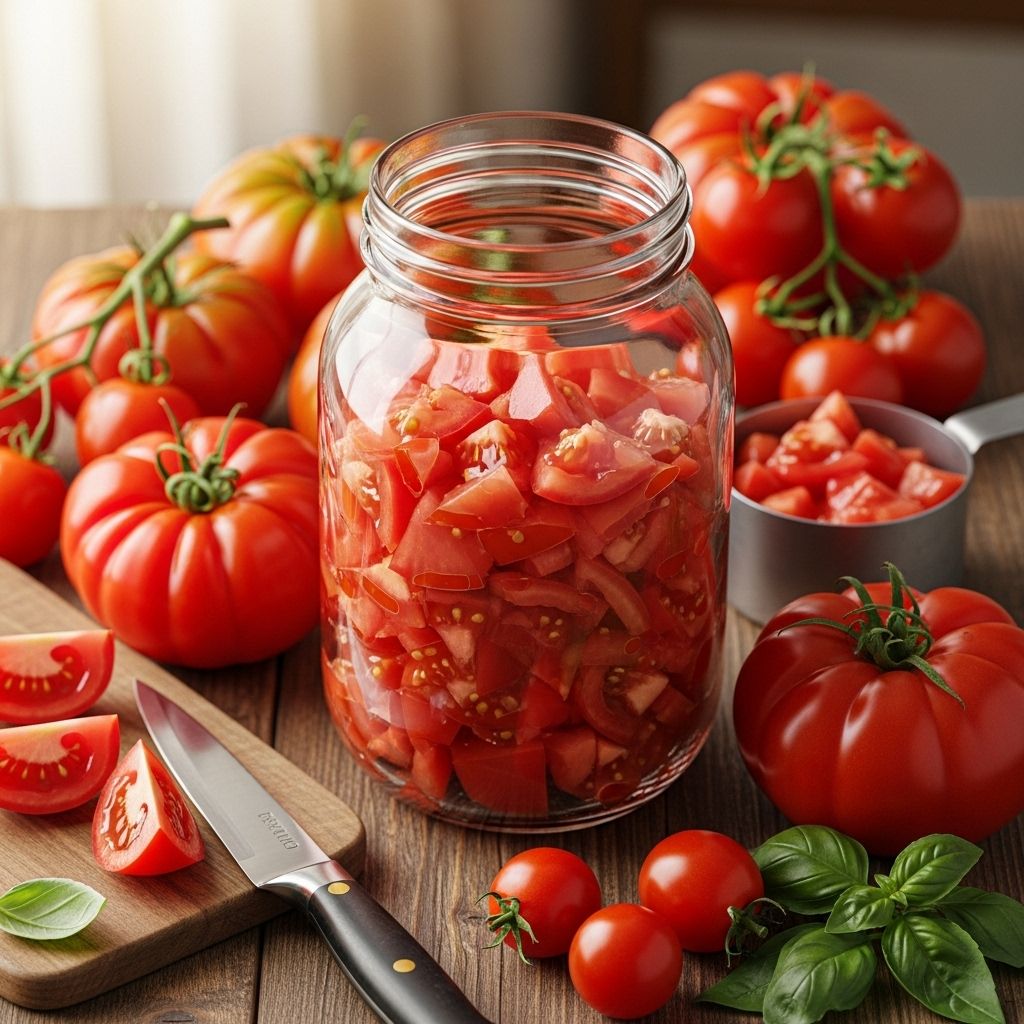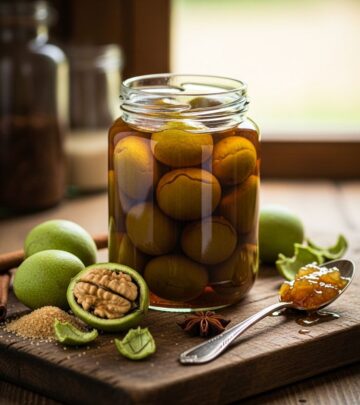How Many Tomatoes Do You Need to Fill a Canning Jar? A Comprehensive Guide
Remove guesswork from home preservation with precise measurements for effortless results.

Image: HearthJunction Design Team
How Many Tomatoes Does It Take to Fill a Canning Jar?
Home canning is a time-honored tradition, preserving the flavors and memories of summer harvests for use all year long. If you’re eyeing a bounty of ripe red tomatoes from your garden or local market, you might wonder: Exactly how many tomatoes does it take to fill a canning jar? This is an essential question for anyone looking to preserve tomatoes efficiently and avoid waste or shortages when setting up your canning assembly line.
Why Tomato Quantities Matter in Canning
Accurately gauging the number of tomatoes per jar:
- Saves time during preparation and processing.
- Prevents food waste by ensuring you prep only what you need.
- Helps organize your harvest if you’re planning to can in bulk.
- Ensures you have sufficient jars and preserving materials (like salt, lemon juice, and basil).
Quick Reference Table
| Jar Size | Average Tomatoes Needed (Pounds) | Notes |
|---|---|---|
| Pint (16 oz) | 1 – 1.5 lbs | Good for small households & sauces |
| Quart (32 oz) | 2 – 3 lbs | Useful for family meals, stews, and soups |
Note: The weights and numbers above are approximate and may vary depending on tomato variety, ripeness, and how tightly you pack the jar.
Choosing the Right Tomato Varieties for Canning
- Plum (Roma) tomatoes: Dense, meaty flesh with fewer seeds and less juice, making them ideal for sauce and canning.
- Beefsteak tomatoes: Larger, juicier, and suitable for chunkier canned tomatoes.
- Avoid cherry and grape tomatoes: Their small size makes peeling labor-intensive, and once skinned, you’re left with very little flesh.
- Mixing varieties: Customize your canned tomatoes by blending plums for thickness and beefsteaks for juicy flavor.
Step-by-Step: Preparing Tomatoes for Canning
- Gather your harvest: Collect as many ripe, firm tomatoes as you can. Soft or overripe tomatoes can affect texture and flavor.
- Wash thoroughly: Rinse to remove dirt, pesticides, and debris.
- Sterilize jars and lids: Arrange jars and lids in a single layer on a baking sheet and bake at 225°F (107°C) for 20 minutes. Alternatively, boil jars and lids in water for 10+ minutes.
- Blanch and peel:
- Score a shallow “X” into the bottom skin of each tomato.
- Plunge 5–10 tomatoes at a time into boiling water for about 1 minute, until skins start to split.
- Remove with a slotted spoon and cool in an ice bath or colander.
- Peel off the loosened skins and core the tomatoes with a sharp knife.
- Remove seeds (if desired): Cut tomatoes into quarters and scoop out seeds and jelly for a smoother sauce or chunkier product. This step is optional.
- Prepare your workspace: Set up a clean area with your sterilized jars, canning funnel, ladle, salt, lemon juice, and seasoning (such as basil sprigs).
How to Fill Canning Jars with Tomatoes
You can pack your jars with either raw or precooked tomatoes, depending on the final texture and taste desired.
Raw Pack Method
- After peeling and coring, pack raw tomatoes into jars, crushing lightly with a spoon to fill voids.
- Add 1/2 teaspoon of salt and 1 tablespoon of lemon juice per pint (double for quarts), plus a fresh sprig of basil for flavor.
- Leave about 1/2-inch headspace at the top for expansion during processing.
- Wipe jar rims with a clean cloth dipped in white vinegar to ensure a good seal.
- Place sterilized lids and rings, tightening finger tight—not overly tight.
Hot Pack (Saucy/Stewed) Method
- After peeling, cut tomatoes and place them in a hot sauté or saucepot.
- Smash with a potato masher and cook for 10–15 minutes on medium to evaporate some water and concentrate flavors.
- Ladle hot tomato mixture into jars with seasoning and lemon juice, leaving 1/2-inch headspace.
- Follow the same sealing process as above.
Processing and Sealing: Steps for Safe Storage
- Water-bath canning: Place filled jars in a large pot or water-bath canner with boiling water at least 1 inch above the jar tops.
- Process times vary by altitude:
- 0–1,000 feet: 85 minutes.
- 1,001–3,000 feet: 90 minutes.
- 3,001–6,000 feet: 95 minutes.
- 6,000+ feet: 100 minutes.
- Carefully remove jars and let them cool at room temperature. Do not disturb as they seal—listen for the satisfying “pop” as the jars create a vacuum.
- Once cooled, check seals by pressing down on the lid. If it doesn’t spring back, the jar is sealed. Reprocess or refrigerate unsealed jars.
What You Need for Canning Tomatoes
- Fresh tomatoes (plum and/or beefsteak)
- Salt (optional, but enhances preservation and flavor)
- Lemon juice (or citric acid; acidifies for food safety)
- Basil (optional, for added flavor)
- Sterilized canning jars with lids and rings
- Large pot or canning kettle
- Slotted spoon, ladle, canning funnel
- Colander, potato masher, kitchen towels
Scaling Up: Batch Calculations for Larger Canning Projects
If you have a considerable harvest, use these approximate batch calculations:
- For 7 quarts of canned tomatoes (standard canner load), about 21 pounds (9.5 kg) of tomatoes are needed.
- For 9 pints, plan for roughly 14 pounds (6.4 kg) of tomatoes.
- Account for trimming losses after peeling and seeding—yield may be reduced by 15–25%.
Keep in mind that juicy heirlooms or beefsteak tomatoes may yield slightly less finished product by volume due to higher water content.
Tips for the Best Home-Canned Tomatoes
- Use tomatoes at peak ripeness for best flavor and texture.
- Acidify every jar with lemon juice or citric acid, regardless of tomato variety, to ensure food safety.
- Skim foam from cooked tomatoes for a clearer finished product and better shelf stability.
- Avoid overfilling jars, as tomatoes expand during processing and can compromise the seal if filled above recommended headspace.
- Cool jars gradually and don’t disturb until fully sealed.
Troubleshooting Common Tomato Canning Issues
- Floating tomatoes: Sometimes tomatoes separate and float after canning. This is cosmetic and not a safety concern. Prevent by using the hot pack method.
- White or cloudy liquid: Could be due to hard water or added salt. Not dangerous, but use distilled water if appearance is critical.
- Unsealed jars: Reseal within 24 hours. Refrigerate or freeze contents if proper seal cannot be achieved.
Frequently Asked Questions (FAQ)
Q: Can I mix various types of tomatoes in one batch?
A: Yes. Mixing different varieties (such as plums and beefsteaks) can optimize texture and flavor. Avoid cherry tomatoes unless using for sauce, as peeling is tedious and yield is low.
Q: Do I need to add lemon juice or citric acid?
A: Yes. Homegrown tomatoes can vary in acidity. Adding lemon juice or citric acid ensures a safe pH for water-bath canning.
Q: Is salt required?
A: No, salt is optional and used primarily for flavor and texture. You may omit salt for low-sodium diets, but do not skip the acid!
Q: What is the shelf life of home-canned tomatoes?
A: If processed properly, jars can last up to 12-18 months in a cool, dark place. Always inspect for broken seals, off odors, or discoloration before use.
Q: Do I need a pressure canner for tomatoes?
A: Not if you acidify with lemon juice or citric acid and use water-bath processing. Pressure canning is required for non-acidified tomatoes or certain recipes.
Ideas for Using Your Canned Tomatoes
- Hearty soups, stews, and chili
- Homemade pasta sauces
- Shakshuka or huevos rancheros
- Savory braises or curries
- Fresh pizza or bruschetta topping
Canning Tomatoes: Empowering Home Food Preservation
Mastering the art of calculating how many tomatoes fill a canning jar streamlines your preservation efforts, ensuring you get the most from your harvest without the headache of guesswork. Whether you’re putting up a handful of pints for winter sauces or loading up multiple family-sized quarts, you’ll have delicious, versatile tomatoes at a moment’s notice for months to come. The knowledge and confidence you gain in jar-to-tomato conversions is an invaluable part of culinary self-sufficiency—one delicious jar at a time.
References
- https://www.favfamilyrecipes.com/how-to-can-whole-tomatoes/
- https://www.gardenista.com/posts/canning-preserving-how-many-tomatoes-does-it-take-to-fill-a-canning-jar/
- https://www.youtube.com/watch?v=9hbKwwRGL64
- https://www.youtube.com/watch?v=OnH2-53h-Y0
- https://www.gardenista.com/posts/modern-day-canning-everything-you-need-to-know-step-by-step-with-sean-pajot-plant-based-diet/
Read full bio of medha deb












